
The Necromateion (or Nekromateion) of Ephyra is as important as Delphi and Delos because it is one of the basic elements of the religion of the Greeks. Namely, it is a part of a complete logic. If Delos symbolizes the beginning of a new life, the Necromanteion is both the end and the beginning of a new life, according to the movement of Apollo (Sun).
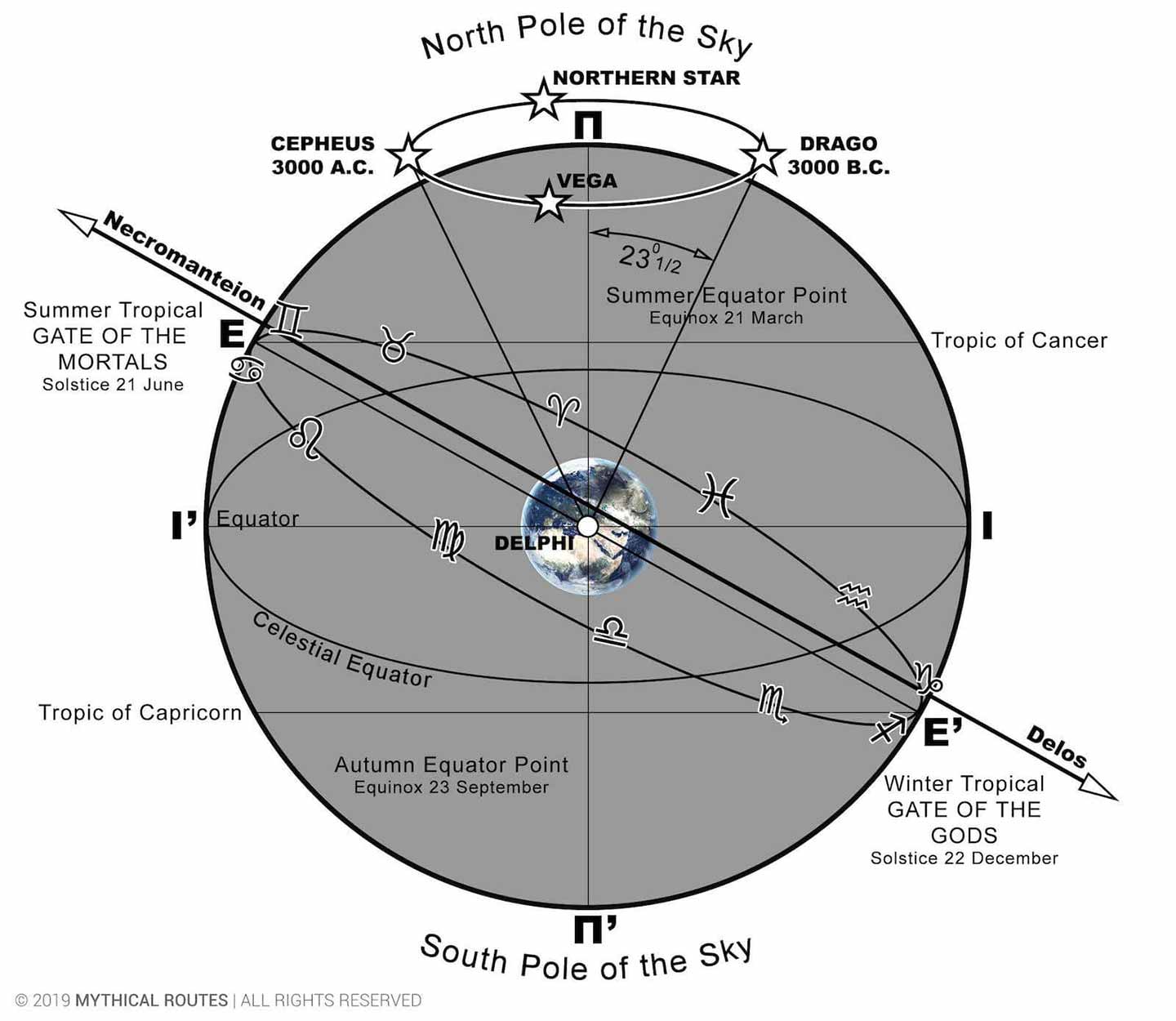
We observe in the above image, that the Sun on 22/12 stops its downward course to the South, the moment it is found in the sign of Capricorn, in the month of Poseidon (December-January) which is visible from Greece and starts its upward course to the North. It is when the winter begins and the human souls passed after death through that zodiac to reach the Heavens ("Gate of the Gods" - Winter Solstice). In reverse on 21/6, the Sun stops its upwards course to the North, the moment it is found in the Sign of Cancer in the month of Skirophorion (June-July) and starts descending to the South. It is the beginning of the Summer and the souls descended through this zodiac to enter new bodies ("Gate of Mortals" - Summer Solstice).
To see the function of this system, we should at the same time raise the axis EE' of the celestial Sphere up to Delphi, which will become a Cosmic Center. Thus the "gate of the gods" will be found to the right of Delos and the "gate of mortals" to the left of the Necromanteion.
The position of the Necromanteion as a central gate to Hades is identified with the movement of the Sun and it can not be located outside of the straight line Delos-Necromanteion. The non-existence of the Necromanteion also abolishes the function of reincarnation. So, the more the Greek civilization spreads, the further the Necromanteion is distanced from Delos. That is why Lucian talks about Hades beyond the Pillars of Heracles (Gibraltar) in 160 A.D.
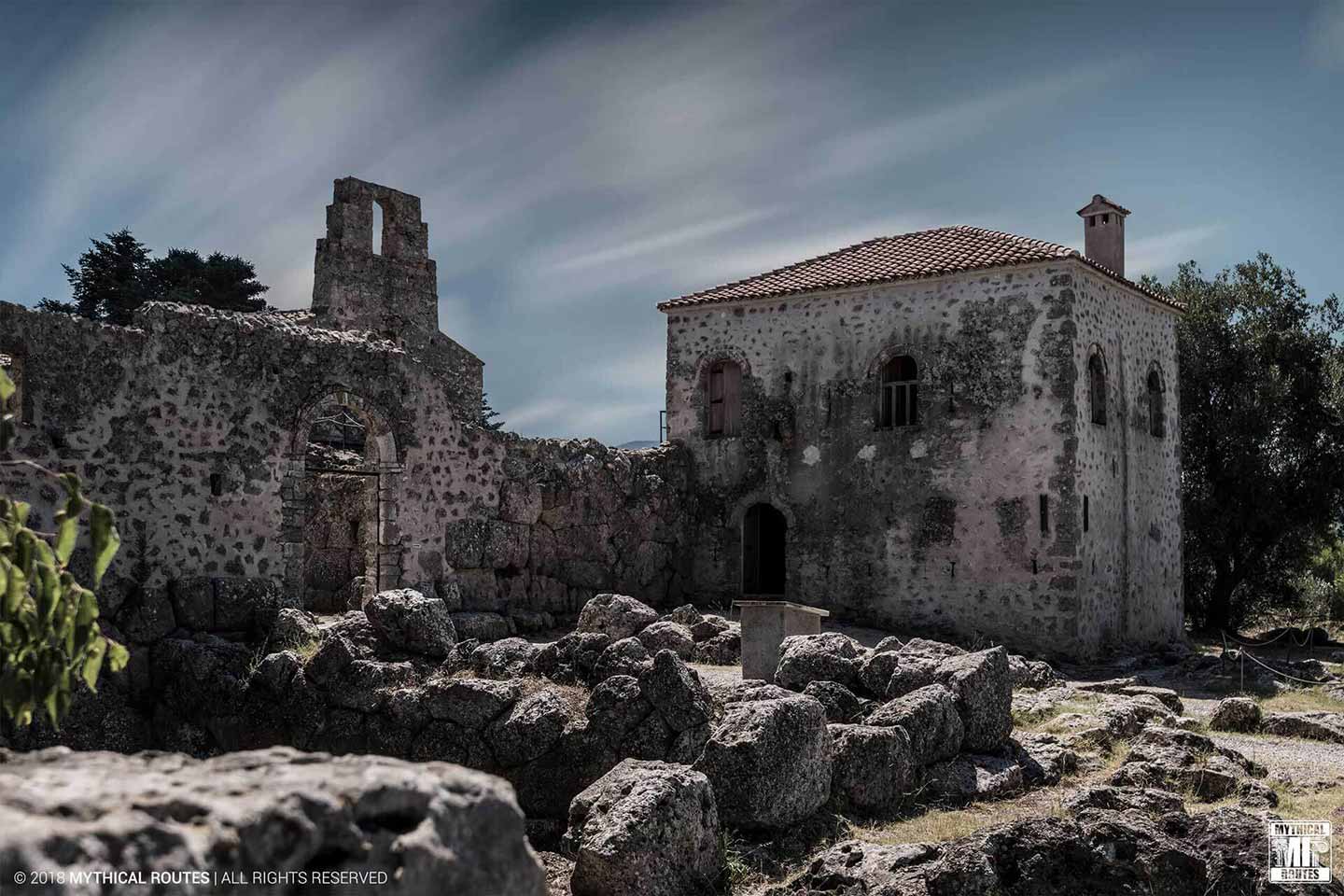
The Necromanteion or Nekyomanteion ("νέκυς" is the Greek word for the dead) of Acheron (image IV) is located in the west part of Epirus, in the province of Preveza, north of the river Acheron. Homer mentions it alongside the sanctuary of Dodoni. It is estimated that it began its operation back in 1500 B.C.
The site of the Necromanteion was visited by many heroes for various reasons, like Theseus, Heracles, the son of Achilles Neoptolemy, Orpheus, Aeneas, Laodamia and Odysseus. They could of course enter Hades through some secondary entrance, but they would end up in the same place because the acreage of Hades is fixed, the Necromanteion, because here lies the Palace of Hades and Persephone, where the river Acheron flows. This way the site of the Necromanteion was advertised so much, that the believers flocked there by the thousands. Moreover, a more systematic promotion of the cults happened during the reign of Pyrrhus, the son of Aeacides and Phthia, who propagated that he was descendant, on his father's side, from Achilles. Pyrrhus was also the second cousin of Alexander the Great. Among the gods he promoted was also Persephone.

Acheron was a son of Gaia who was sentenced to remain underground because he helped the Giants in their battle with the Olympian Gods. So this cold river for large periods of time was lost under the earth and reappeared, forming a dirty stagnation, with a depressing landscape; the lake Acherusia (image V) the name of which comes from the word "άχος" (achos) which means "sorrow". Then it headed to the west towards the Ionian Sea. Cocytus, the "river of sighs" and Phlegethon, the "fiery river", were two tributaries that both flowed into the river and the lake. Cocytus also flowed the underground waters of the chasm of Styx. It was in this chasm that Thetis sank her son Achilles to make him immortal, with sole vulnerable spot the part of the foot where she held him from.
The scene was completed by deaths from malaria, because of the mosquitoes that arrived in swarms in the surrounding area and of the birds or animals which died from the fumes of the lake. Moreover, in the winter the whole flatland stagnated, leaving a hill above the surface of the water, like an island, on which the Necromanteion stood, at the point when Acheron moved towards the sea.
So then Charon transports with his boat the souls through the swamps of Acheron, to the other bank of the river for the cost of an obol (1/6 of a drachma). Acheron, just like the Nile of Egypt, is a border between Life-East and Death-West, as it descends from the North to the South. Charon directs the funerary boat and the souls row, through the environment we described. On the other bank Hades (Invisible) awaits with Cerberus and Orthus, his dogs, to transport the souls to the chthonic space, in order for them to be judged by Rhadamanthus and Sarpedon who were brothers of Minos, and the son of Zeus Aeacus. After judgment, the souls would proceed either towards the fountain of oblivion, next to the white cypress to the left of Hades, or they would follow the path to the fountain of remembrance, to the right, walking towards immortality. Judgment was about the serving of justice, namely punishment for those who headed towards the fountain of oblivion and reward for those who headed for the fountain of remembrance. The opinion of the Orphics was that the soul, depending on the mistakes of man while living, will enter into another body of an animal or human for catharsis and deliverance.
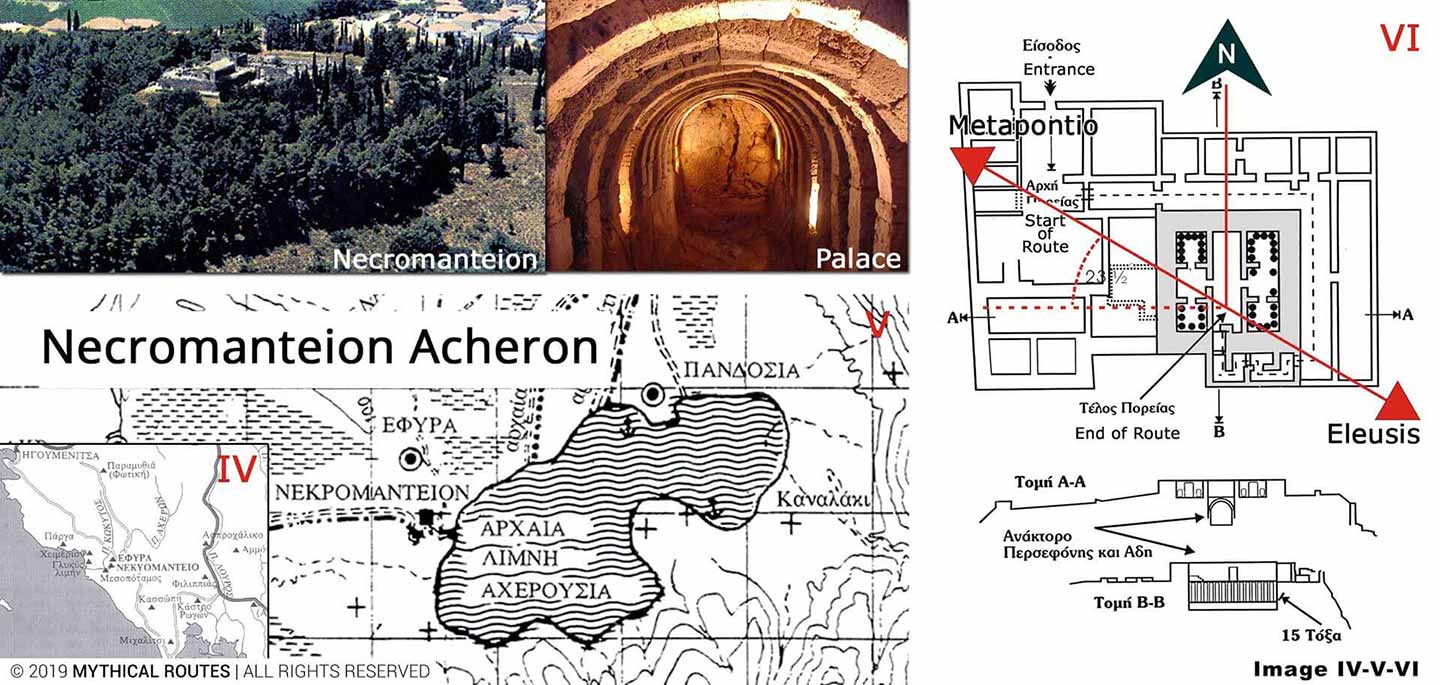
The Necromanteion (Image VI) is composed of the main Sanctuary which is a square with sides of 22 meters, within an auxiliary site that surrounds it. If we compare the Telesterion of Eleusis with the main shrine of the Necromanteion, we will observe that the two buildings are similar because both are structural representations of Hades. Their structural differences come from the different use of sacred sites.
Archeologist S. Dacaris dates the main Sanctuary of the Necromanteion 150 later than that of Eleusis; this indicates that it followed the structural logic of Ictinus (Pericleon). Despite this, the exterior of the Necromanteion seems structurally primitive, like the walls of Tiryns, namely a construction based on the Lesbian structure. According to architect and archeologist A. Orlando, this system is known in the 7th century B.C., rises in the 6th century B.C., and declines in the 5th century B.C. In any way, it is clear that the clergy follows certain basic construction models so that the believer is not confused.
The believer enters the Necromanteion from the North through a courtyard with the auxiliary spaces and the rooms for priests and visitors. From there he would turn to the east to enter the northern corridor of the oracle, where (to the left) there were rooms for the preparation of the visitor, a psychological and physical preparation, in a completely dark space, where circulation was only possible by candles. He ate foods, like in the funerary dinners, which essentially drugged him and he heard hollow prayers to the chthonic gods. After his cleansing with water, he followed, escorted by the priest, the eastern corridor, throwing along the way a stone on a pile to remove the bad influence. Next, washing his hands in a marble sink, like they do in catholic churches, he would enter with a western direction the corridor of the Labyrinth, which is located south, where he was completely disoriented and only with the help of the Priest he would be able to proceed. If the modern visitor repeats the same course blindfolded and with the help of a friend because the temple is in ruins, he will have the same result as the believers once had.
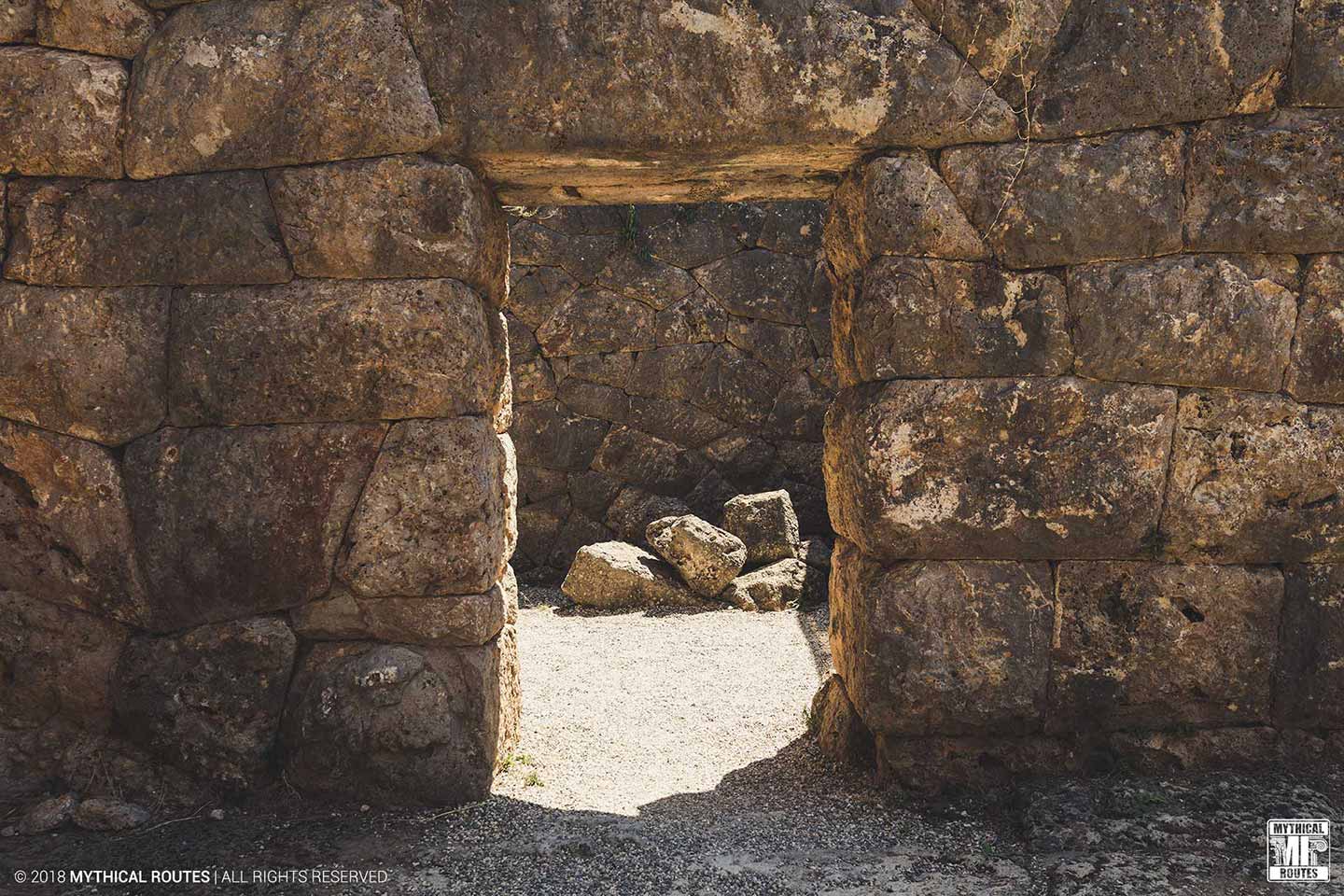
The Labyrinth was constructed by three arched metal gates, which represented the gates of Hades; therefore in this exact place begins the use of the curvilinear construction for the chthonic gods, (you can read more about Rectilinear and Curvilinear architecture here). The believer would finally turn to the North and reach the main hall, where the invoked deceased of the visitor appeared in the back, accompanied by the idol of Persephone, who had her palace below the hall.
The thick walls of the main part of the sanctuary, according to the archeologist S. Dakaris, concealed hallways so that the Priests could move around unseen. In fact, one such corridor was discovered between two exterior walls. Consequently, the believer would talk to the back of the hall, asking for answers, which he actually received from the clergy. Of course, no one questioned the process we described, since even Lucian, to avoid the accusation of “irreverence” in 160 A.D., moved the scene of necromancy from Acheron to Mesopotamia. During his departure, the believer left through a different exit, in absolute silence, because the announcement of anything he saw and heard incurred the death penalty.
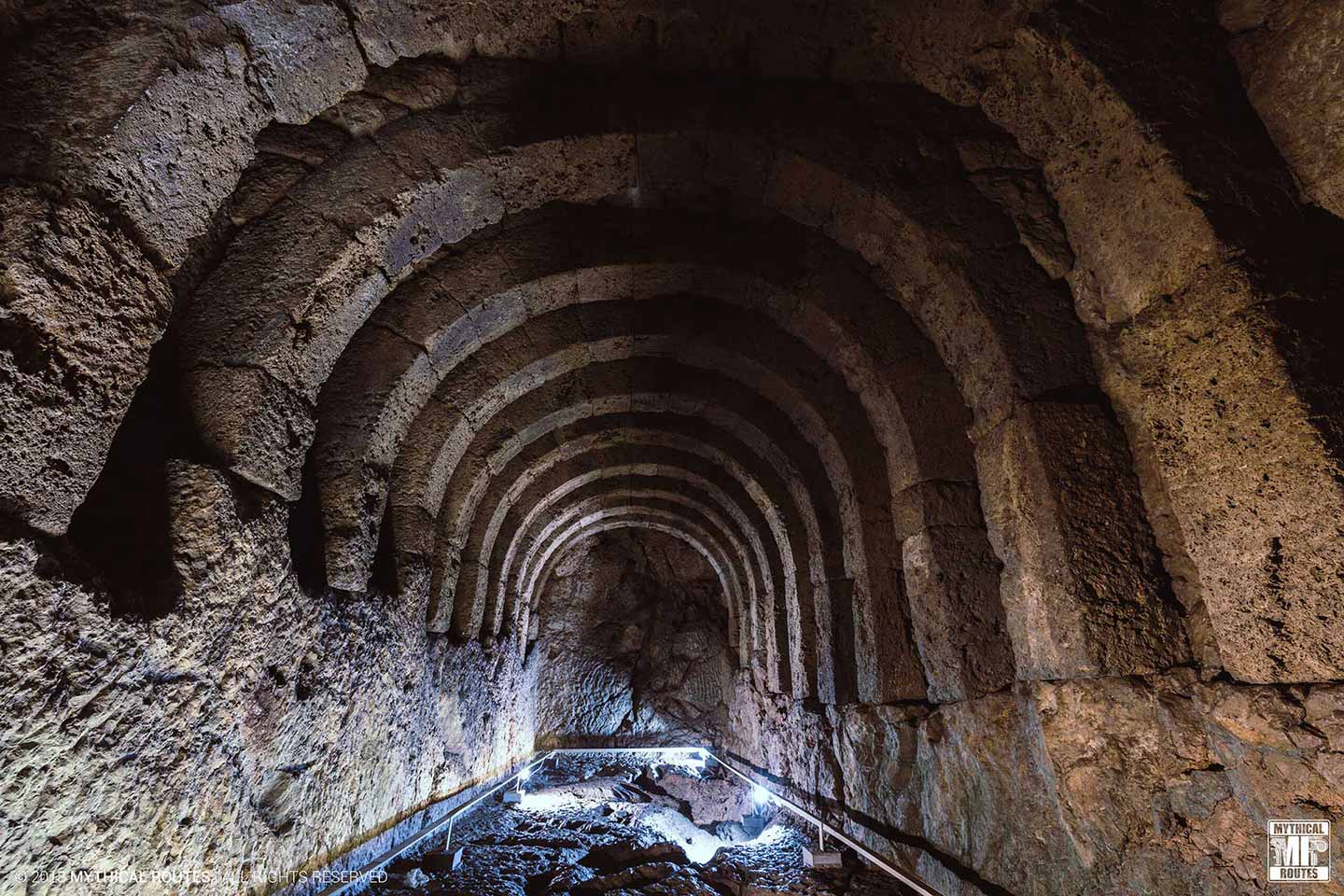
Below the central hall where the believer conversed, was located the Palace of Hades and Persephone, with the fifteen chthonic arches. The floor was natural rock, rugged because it was about the chthonic nature - "Gaia". In the back, the long and narrow room facing north ended in a rock wall, through which the souls passed to main Hades to be judged. It is from there that the souls came to meet the living believer who invoked them on the upper floor, from the roof of which, the idol of the goddess was raised and lowered. On the northern side of the basement of the Palace of Persephone then, exists a theoretical gate, in the form of a tunnel. And because it is about a soul, there was no reason for openings, as the souls can phase through matter. This is a logic that we inherited and that is why it does not cause us questions when we are told about it or we watch it in the movies.